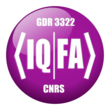| Main contact : | Catherine Gourdon |  |
Research activities:
The research activities of the Quantum Nanostructures (QN) group are related to the fields of quantum information, spintronics, molecular electronics and nanophotonics.
The electronic, magnetic and vibrational properties of quantum nanostructures: quantum dots and nanocrystals, quantum wires (organic or inorganic), quantum wells (doped and/or magnetic), and multi-layered structures, are investigated. A large part of our activity is devoted to III-V and II-VI semiconductors and to polydiacetylene polymers. The QN group is composed of experimentalists - most of them are specialists in optical spectroscopy - and theoreticians.
Research topics:
Quantum information processes requires the use of quantum bits, defined as two-level systems, with long coherence time in order to be easily manipulated. We investigate various charge or spin quantum states (excitons in quantum wires and dots, donor states, electrons in doped quantum dots). The spatial and temporal coherence properties of these quantum states are studied by means of single-nanostructure spectroscopy and time-resolved pump-probe measurements. The coherent control of two-level systems is currently developed. Entanglement of two or more quantum bits will be the next step.
In the field of spintronics, the understanding of spin-related phenomena in magnetic or non-magnetic doped nanostructures is of paramount importance for using spin as information vector. Spin dynamics is studied in quantum confined nanostructures and ferromagnetic semiconductor layers by pump-probe techniques. Magnetic domain structure and domain wall motion is investigated in ferromagnetic semiconductors (also in type I superconductors) using magneto-optical Kerr microscopy. Electronic excitations in two-dimensional (2D) and one-dimensional nanostructures are investigated by means of electronic Raman spectroscopy: collective and individual spin polarized excitations of a 2D electron gas; electronic excitations in quantum wells and wires.
Phonons and magnons in superlattices and nanocrystals are investigated by Raman spectroscopy. Novel multilayered structures combining phononic cavities and photonic cavities are designed and studied by Raman scattering and picosecond acoustics (in collaboration with another group at INSP).
Theoretical studies on the exact nature of composite bosons are actively pursued in the QN group. A novel and very powerful many-body theory, with an appropriate diagrammatic representation, has been developed. Its impact in semiconductors physics, but also in the field of superconductivity and cold atoms gases, is currently investigated.
Several complementary and very competitive experimental setups have been developed in the past few years: scanning-imaging optical spectroscopy of individual nanostructures, time-resolved pump-probe techniques, Faraday microscopy, angle-resolved electronic Raman spectroscopy under magnetic field.
For more information: see online Nanostructures and Q Systems




